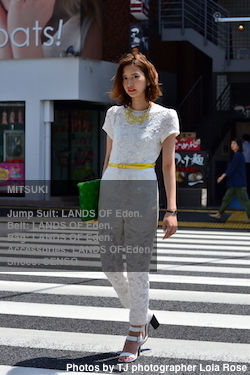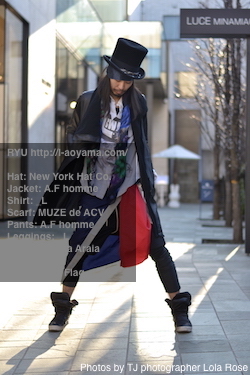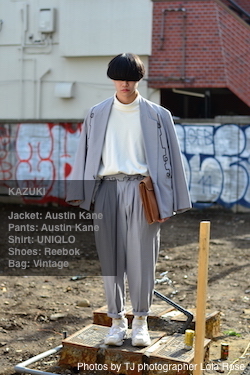On Japan Category (104)
Incomparable Kareem Abdul-Jabbar
Far More than the Greatest Basketball Player of All Time
Interview by Anthony Al-Jamie
It's little wonder that Kareem Abdul-Jabbar has been called the greatest basketball player of all time. After a record-breaking college career under the great John Wooden at University of California, Los Angeles (UCLA), the 7'2" history major made history himself during 20 seasons from 1969 to 1989 in the National Basketball Association (NBA) playing center first for the Milwaukee Bucks and then the Los Angeles Lakers. He continued to break record after record as the all-time leading scorer in NBA history, a six-time NBA Most Valuable Player (MVP) and a 19-time NBA All-Star, reaching the finals with eight NBA championship teams (six as a player and two as an assistant coach). Born in New York City on April 16, 1947 as Ferdinand Lewis Alcindor, the basketball hall of famer, who was known on the court for his trademark "skyhook" jump shot, is also known off the court as an actor, martial artist, historian, philosopher, public speaker, businessman, philanthropist, education advocate and as a best-selling and highly regarded author. Kareem has traveled the world for his sport and was appointed as a U.S. global cultural ambassador by Secretary of State Hillary Clinton in 2012. Tokyo Journal Executive Editor Anthony Al-Jamie met with living legend Kareem Abdul-Jabbar to explore his remarkable life both on and off the court.
Streetstyle Glamour
Tokyo Journal photographer Lola Rose captures the latest in street fashion in her photo column "Streetstyle Glamour."
The complete article can be found in Issue #275 of the Tokyo Journal. Click here to order from Amazon.
Garrity's Japan
Editor’s Insight
Garrity’s Japan
A Visit to the Shirakawa Barrier
The following is a continuation of Robert Garrity’s story describing his walk across Japan; a journey replicating haiku poet Matsuo Basho’s 1,500-mile journey from Fukagawa, Tokyo to Japan’s northern wilderness, as detailed in Basho’s world-famous travel diary, “Oku no Hosomichi.” Garrity began the first leg of his journey in the summer of 1994, and he continues walking different segments each time he returns to Japan.
Shortly after my military assignment to Japan in late 1957, I developed an interest in Japanese history. I have had an interest in history most of my life, so my newly developed interest in Japanese history was not a surprise. In the late ‘50s, however, the availability of books on Japanese history in English was rather limited. I read every book I could beg, borrow, or even steal. Occasionally in my reading, I would come across a geographical location called the Shirakawa Barrier.
The Heroic Dr. Henry Heimlich
The Doctor Who Has Saved More Lives Than Any Other Human Being Alive Today
Interview by Anthony Al-Jamie
Dr. Henry Heimlich is perhaps the most important person I have interviewed in my entire career. He has invented medical procedures and devices that have saved, and continue to save, hundreds of thousands of lives every year. His medical innovations include the famous Heimlich maneuver, an approach to dislodging food from choking victims that can be done by just about anyone without any tools. Its success earned him celebrity status in the late 1970s on the talk show circuit including Johnny Carson’s “The Tonight Show.” Another innovation is the Heimlich Chest Drain Valve, a device that helps to prevent lungs from collapsing when bleeding occurs by draining air and liquid from the chest. This medical device is used in hospitals throughout the world, by police and emergency personnel to save the lives of gun shot victims, and by military personnel in just about every combat zone since the Vietnam War where the device saved lives on both sides of the line. Dr. Heimlich’s Micro-Trach is said to maximize oxygen intake, outperforming nasal cannulas, while completely concealing oxygen tubes under patients’ shirt collars. His remarkable work with the reversed gastric tube operation in the 1950s was the first full-organ transplant performed outside of the Iron Curtain and allowed patients with a damaged esophagus to swallow again. This is Part 1 of a series of interviews with the renowned Dr. Henry Heimlich.
Fumiko Hayashi
Leading a Revolution in Equality & Sustainability
Yokohama Mayor Fumiko Hayashi Sets her Sights on Making Yokohama the Most Progressive City in the World
How does one go from an entry-level sales position at a Honda dealership to president of Volkswagen, BMW and Nissan Auto Sales in Tokyo, chairperson and CEO of Daiei (one of Japan’s largest supermarket retailers) and now mayor of Japan’s second-largest city, Yokohama? How do you do all of this despite traditions that cast men as the salary-earners and women as domestic caregivers? And while being only a high school graduate in a society that places extreme importance on university qualifications? Break all the precedents, says Fumiko Hayashi. She has dominated both the corporate and political worlds in her long and ground-breaking career, a career that she forged for herself despite – and at times because of – her gender. Fumiko Hayashi has been listed as the most powerful woman in Japan and 39th out of the Forbes 2006 list of “The 100 Most Powerful Women.” Tokyo Journal Executive Editor Anthony Al-Jamie first interviewed Fumiko Hayashi for TJ while she was still president of Volkswagen in 2003. Now over a decade later, he catches up with Japan’s corporate icon and current mayor of Yokohama to find out how her views have developed and what she has to say about gender equality, economic success and the future of Yokohama.
Tokyo Street Fashion/Harajuku
Tokyo Journal Street Photographer Malgorzata Dittmar hits the streets with her lens to see what's hot in Harajuku
The complete article can be found in Issue #275 of the Tokyo Journal. Click here to order from Amazon.
Tokyo Street Fashion/Harajuku
Tokyo Journal Street Editor Kjeld Duits hits the streets with his lens to see what's hot in Harajuku
The complete article can be found in Issue #274 of the Tokyo Journal. Click here to order from Amazon.
After the Inferno
After the Inferno
by Donald Richie
In this installment of a series, Donald Richie recalls a poignant post-war moment with Nobel Prize-winner Yasunari Kawabata
It was 1947 and the Sumida River, silver in the winter sun, glistened beneath us. Yasunari Kawabata and I were on the roof of the Asakusa subway terminal tower, looking out over downtown Tokyo, still in ruins, still showing the conflagration of two years earlier, the burned concrete black against the lemon yellow of new wood.
Horiyoshi III
Horiyoshi III
Japan’s Legendary Tattoo Master
Interview by Kimo Friese and Horikichi
TJ: Can you introduce yourself to our readers?
HORIYOSHI: My real name is Yoshihito Nakano. I was born on March 9, 1946 in Shimada, Shizuoka. I am the eldest son with a sister and brother.
TJ: Tell us a little about Irezumi, the traditional art form of Japanese tattooing.
HORIYOSHI: It depends what you mean by traditional? Tattoo tradition, Japanese tradition or Asian tradition? If you say Asian tradition, it was most affected by Confucianism. But if you are obedient to Confucianism, you can’t get tattooed because the belief states that you should not hurt your body. But since tattoo culture had already existed before the ancient Chinese ideas that transformed into Samurai philosophy in Japan, Confucianism couldn’t exclude tattoo culture. The concept of the tattoo can translate into strength, religion, or many other things. But in Japan, it basically represents courage or strength, like the Samurai’s fighting spirit. On the other hand, tattoos also have artistic aspects. Actually, it’s difficult to talk about Irezumi tattoo and tradition because the scope is too wide.































